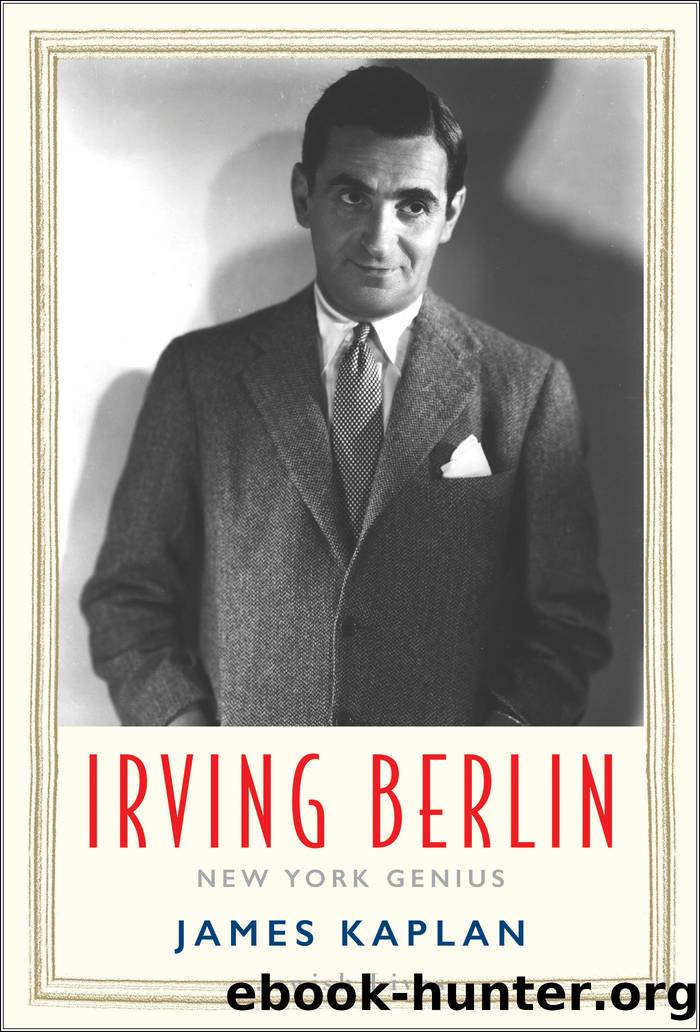Irving Berlin by James Kaplan;

Author:James Kaplan;
Language: eng
Format: epub
Publisher: Yale University Press
Published: 2019-07-14T16:00:00+00:00
17
This Is the Army, Mr. Jones
AS A BRUISED and reeling USA jumped into war mode at the dawn of 1942, so did Irving Berlin. All at once, history had given him permission to alchemize the anxiety of the past three years into a big idea, and one came to him quickly: an updated revival of his World War I all-soldier revue Yip! Yip! Yaphank—as a Broadway fund-raiser for the entire U.S. Army. In late February, Berlin phoned the army chief of staff, General George C. Marshall, to pitch the idea, and on March 11 he received an official go-ahead on War Department stationery. Berlin’s stilted reply reflected both his exaltation and his slight discomfort before high-Wasp military authority. “I am delighted to accede to your request,” he wrote. “I need not assure you that I will give this all my time because nothing is closer to my heart.”1 He was speaking with utter honesty about his powerful feelings of patriotism, but whether consciously or unconsciously, was also expressing another of his heart’s desires: here, at long last, was the chance to do another revue.
He went to work immediately, setting up shop in early April at his old stomping ground, Camp Upton, and like a commanding general himself, throwing together a staff: a copyright manager for the new songs he would write (all the profits from which—more than six million dollars in the end2—would go to the Army Emergency Relief Fund), stage and music directors, costume and set designers, and a first sergeant to make sure the three hundred cast members the War Department promised him would maintain army spit and polish.
He decided to call the new show This Is the Army. And thanks to his new friends in the War Department, Berlin had the luxury of cherry-picking its cast—a number of them professional entertainers in civilian life—from combat divisions around the country. Freed from the need to negotiate with the Musicians Union, he was also able to assemble a full orchestra of forty-four pieces, many more than would be found in the pit of a standard Broadway musical.3
Moreover, Berlin’s troupe wasn’t varied only geographically: at his insistence, the army permitted him to recruit some two dozen black soldiers for his company. At a time when the armed forces were still segregated, the choice was revolutionary, but also, given the centrality of African Americans in American show business, thoroughly practical. Just like that, the cast of This Is the Army became the only integrated unit in the armed forces in World War II.
The revival as Berlin conceived it, Jablonski writes, would have the same basic structure as Yip! Yip! Yaphank, “opening with a minstrel show that led into a vaudeville segment (with acrobats, jugglers, and a magician), interspersed throughout with musical numbers and dances. Once again, impersonations of celebrities peppered the second act, set in New York’s by-then-famous Stage Door Canteen.”4
And in the next-to-last number on the bill Irving cast himself, back in his World War I uniform, complete with wide-brimmed campaign hat and puttees, reprising “Oh, How I Hate to Get Up in the Morning.
Download
This site does not store any files on its server. We only index and link to content provided by other sites. Please contact the content providers to delete copyright contents if any and email us, we'll remove relevant links or contents immediately.
| Military | Political |
| Presidents & Heads of State | Religious |
| Rich & Famous | Royalty |
| Social Activists |
Waking Up in Heaven: A True Story of Brokenness, Heaven, and Life Again by McVea Crystal & Tresniowski Alex(37003)
Empire of the Sikhs by Patwant Singh(22172)
We're Going to Need More Wine by Gabrielle Union(18072)
Hans Sturm: A Soldier's Odyssey on the Eastern Front by Gordon Williamson(16620)
Leonardo da Vinci by Walter Isaacson(11901)
The Radium Girls by Kate Moore(10907)
Educated by Tara Westover(7061)
Tools of Titans by Timothy Ferriss(6945)
How to Be a Bawse: A Guide to Conquering Life by Lilly Singh(6692)
The Last Black Unicorn by Tiffany Haddish(5075)
Permanent Record by Edward Snowden(4996)
The Rise and Fall of Senator Joe McCarthy by James Cross Giblin(4843)
Promise Me, Dad by Joe Biden(4447)
The Wind in My Hair by Masih Alinejad(4424)
The Crown by Robert Lacey(4105)
A Higher Loyalty: Truth, Lies, and Leadership by James Comey(4032)
The Iron Duke by The Iron Duke(3639)
Joan of Arc by Mary Gordon(3257)
How to be Champion: My Autobiography by Sarah Millican(3185)
